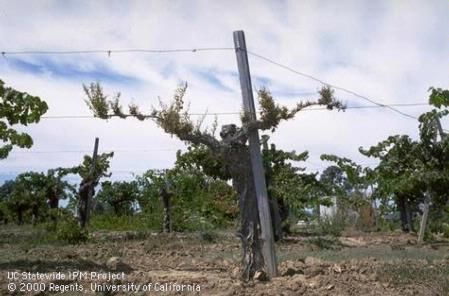
Thanks to December's rains, I can breathe a sigh of relief that my fall-planted cover crops are growing, unlike last year. Now I look toward pruning and preventing Eutypa dieback, a fungal disease, from invading my grapevines this winter.
Pruning is one of the most important tools in my toolbox to manage vine growth. I can control the size of the vine by pruning to a set number of buds, or potential shoots. If I leave too many buds, I may end up with too much fruit, not enough shoot growth and an over-cropped vine that can't mature all its fruit. If I leave too few, I may create too much vigor, causing excessive shading, not enough fruit and fruit of poor quality. It is a balancing act. When I prune, I assess each vine individually.
Eutypa dieback comes from a pathogen that causes cankers, resulting in vine decline and a huge economic loss for growers due to lower yield and treatment costs. This pathogen is prevalent on the North Coast and infects more than 80 plant species worldwide. Some of the hosts in our area include grapes, apricots, cherries, almonds, pears, apples, crabapples, willows, big-leaf maples, oleanders, California buckeye, ceanothus, blueberries and kiwifruit.
Pruning wounds are infected with Eutypa by wind- or rain- driven spores. It maybe several years before symptoms show up. Ultimately, the disease kills the vine. When a vine is five to six years old, you may begin to see the symptoms: stunted shoot growth or no shoot growth. If you looked at a cross-section of the vine, you would see a wedge-shaped canker.
These symptoms are easier to see in spring before the canopy grows too large, so spring is the time to flag diseased vines for removal later. You can combat Eutypa by cutting out the infected area until you see only healthy tissue and no cankers. Make sure to dispose of all infected material.
I try to manage Eutypa in several ways. One strategy is to prune as late as possible, after spore concentrations peak. Pruning wounds, which remain susceptible for up to six weeks, are less susceptible when temperatures are warming. The wounds heal much more quickly and might be colonized by beneficial microbes that grow over the pruning wounds and prevent infection. I also try to avoid creating large wounds and instead make smaller cuts, which heal faster and have less surface area for spores to land on.
Double pruning is also an option, especially if you have many vines to prune. This is a common practice in our valley. For the first pass, the vine is cut 10 to 12 inches above the spur; final pruning happens later in winter or spring when conditions are less conducive to transmitting the fungus. That second pass can move much more quickly, and the chance of infection is minimized.
Wound protection is another option, by organic or conventional methods. You can view photos of Eutypa and recommendations for control at http://www.ipm.ucdavis.edu. Search for Eutypa dieback.
Napa County Master Gardeners are offering a home vineyard workshop on Saturday, February 7 (information below), which will address these topics in more detail.
Workshop: Join Napa County Master Gardeners on Saturday, February 7, for “Home Vineyard: Part 1.” Learn what to do, what to look for, and what to plan for in the vineyard between February and August. A follow-up workshop will be held in August. Location: U. C. Oakville Experimental Station, 1380 Oakville Grade Road, Oakville. Classroom discussion from 9:30 a.m. to 11:30 a.m. Discussion moves into the vineyard from 12:30 p.m. to 2:30 p.m.
Online registration (credit card only)
Mail-in registration (cash or check only)
Master Gardeners are volunteers who help the University of California reach the gardening public with home gardening information. Napa County Master Gardeners ( http://ucanr.org/ucmgnapa/) are available to answer gardening questions in person or by phone, Monday, Wednesday and Friday, 9 a.m. to Noon, at the U. C. Cooperative Extension office, 1710 Soscol Avenue, Suite 4, Napa, 707-253-4143, or from outside City of Napa toll-free at 877-279-3065. Or e-mail your garden questions by following the guidelines on our web site. Click on Napa, then on Have Garden Questions? Find us on Facebook under UC Master Gardeners of Napa County.